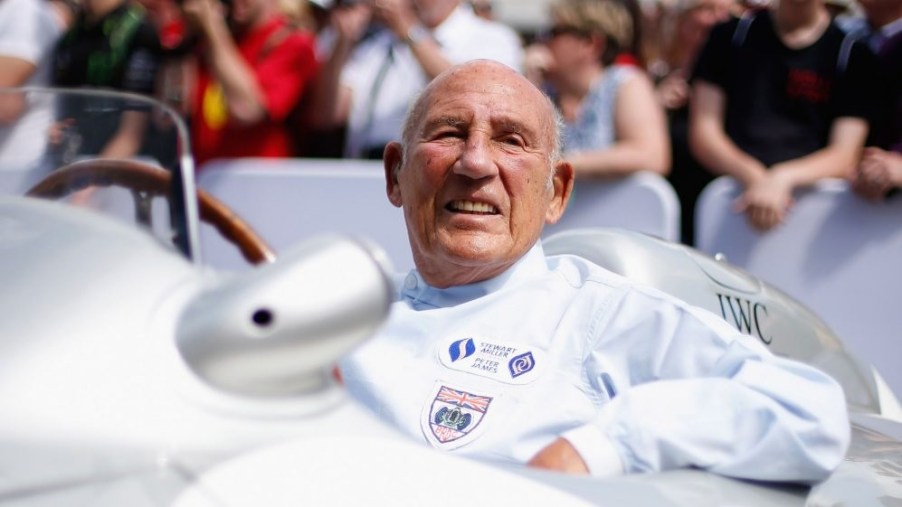
Remembering Racing Legend Sir Stirling Moss
Many legends and heroes have come out of motorsports. Sometimes, they’re team owners or influential builders, like Enzo Ferrari and Ferruccio Lamborghini. Other times, they’re victorious racers, like Ricky Brabec, the first American to win the Paris-Dakar. Or Mike “The Bike” Hailwood, one of the greatest Isle of Man TT racers ever. And whether it’s on the track or at home, it’s always a loss when someone like them passes. This is why the entire racing world now mourns at the passing of legend Sir Stirling Moss.
Sir Stirling Moss drove almost everything
Born in 1929, Sir Stirling Moss’ racing career, Motor Trend reports, began in 1948. He started with 500cc mid-engine Formula 3 cars, Car and Driver reports, winning 12 of 15 races he entered that year. But although he officially started as a Formula 1 driver in 1954, he wasn’t only an F1 racer.
His first international win was actually in rallying, at the 1950 RAC Tourist Trophy in Northern Ireland. Even after retiring from F1 following a 1962 crash that left him partially paralyzed for months, he still competed in international rally races and sports car championships, MT reports. And his greatest victory, in fact, wasn’t an F1 race, but a sports car one.
The 1955 Mille Miglia
Sir Stirling Moss, Autoweek reports, was often called “the Uncrowned Champion.” That’s because, despite winning 16 of the 66 F1 races he competed in, the BBC reports, he never won an F1 Championship. But he’s still remembered as the winner of what MT calls “the most epic drive of all time:” the 1955 Mille Miglia.
The Mille Miglia, in its original 1927-1957 form, was a literal 1000-mile (hence, ‘Mille Miglia’) race set in Italy, running from Brescia to Rome and back again. The race took place on public roads, which meant dust, loose cobblestones, with spectators crowding every corner. And often, Autocar reports, taking said corner at speeds of 170 mph with only your co-driver’s notes to guide you.
All this, over 1000 miles, in an open-topped Mercedes-Benz 300SLR with drum brakes and heavy steering. In a time, Automobile Magazine describes, when racing drivers purposefully kept seat belts unstrapped so they could be thrown clear of the car. While oil and gas fumes, road debris, and brake dust flew into your face. And MT reports, because of how much Moss had to concentrate, his co-driver Denis Jenkinson used hand signals to communicate.
By the time the race was over, Moss and Jenkinson had been driving for 10 hours, 7 minutes, and 48 seconds. Their sole stop took 64 seconds when Mercedes mechanics changed the wheels and topped up the gas tank. The duo averaged just under 98 mph during the race. Not only did they win, they were the first Brits to do so and only the 3rd non-Italian duo. And their record still stands to this day.
But I would argue one of Moss’s greatest achievements wasn’t a race, but how he carried himself.
Sir Stirling Moss was a sportsman
Sir Stirling Moss never won an F1 title. From 1955-1958, he repeatedly finished in 2nd place overall. And from 1959-1961, he came in 3rd place. But he could’ve won in 1958, Petrolicious reports.
At the 1958 Portuguese Grand Prix, fellow British racer Mike Hawthorn spun and stalled on an uphill part of the track. To get it started, MT reports, Moss shouted at Hawthorn to bump-start it by rolling it downhill. To race officials, it looked as if Hawthorn had reversed down the course, which was a disqualifiable offense. This would leave Stirling Moss with enough points to clinch the title.
But Moss instead spoke in Hawthorn’s defense. Hawthorn, he said, hadn’t been on the track at the time, and so shouldn’t be disqualified. So, Hawthorn kept his 2nd-place points and beat Moss to the F1 title by a single point.
That was Moss, Autoweek muses. He never deliberately crashed into anyone or attempted to take out a teammate to win himself. To quote the British Racing Drivers’ Club, “He was universally recognized [sic], following the retirement of the great Juan Manuel Fangio in 1958, as the racing driver who set the standards by which all other drivers were judged, whether in Formula 1 or international sports car racing.”
The leadup to his death

After his F1 retirement, Moss became a businessman, as well as a brand spokesman. He was officially knighted in 2000, becoming Sir Stirling Moss. He also served as a racing commenter and an honorary judge at automotive events around the world. But, the BBC reports, he still occasionally competed in historic car events up until the age of 81.
He retired from public life in 2018, due to health concerns. He’d previously been hospitalized for 134 days in 2016 to recover from a chest infection, Autoblog reports. And on April 12, 2020, he passed away at home at the age of 90.
RIP Sir Stirling Moss.
Follow more updates from MotorBiscuit on our Facebook page.


